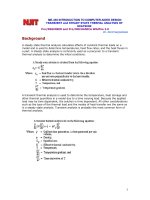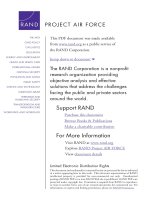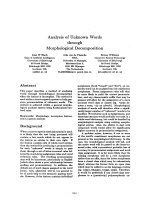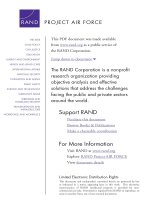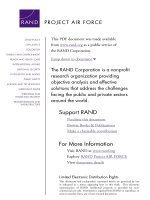Supporting Air and Space Expeditionary Forces - Analysis of Maintenance Forward Support Location Operations potx
Bạn đang xem bản rút gọn của tài liệu. Xem và tải ngay bản đầy đủ của tài liệu tại đây (2.02 MB, 142 trang )
This PDF document was made available
from www.rand.org as a public service of
the RAND Corporation.
6
Jump down to document
Visit RAND at www.rand.org
Explore RAND Project AIR FORCE
View document details
This document and trademark(s) contained herein are protected by law
as indicated in a notice appearing later in this work. This electronic
representation of RAND intellectual property is provided for non-
commercial use only. Permission is required from RAND to reproduce, or
reuse in another form, any of our research documents.
Limited Electronic Distribution Rights
For More Information
CHILD POLICY
CIVIL JUSTICE
EDUCATION
ENERGY AND ENVIRONMENT
HEALTH AND HEALTH CARE
INTERNATIONAL AFFAIRS
NATIONAL SECURITY
POPULATION AND AGING
PUBLIC SAFETY
SCIENCE AND TECHNOLOGY
SUBSTANCE ABUSE
TERRORISM AND
HOMELAND SECURITY
TRANSPORTATION AND
INFRASTRUCTURE
The RAND Corporation is a nonprofit
research organization providing
objective analysis and effective
solutions that address the challenges
facing the public and private sectors
around the world.
Purchase this document
Browse Books & Publications
Make a charitable contribution
Support RAND
This product is part of the RAND Corporation monograph series.
RAND monographs present major research findings that address the
challenges facing the public and private sectors. All RAND mono-
graphs undergo rigorous peer review to ensure high standards for
research quality and objectivity.
Amanda Geller, David George, Robert S. Tripp,
Mahyar A. Amouzegar, C. Robert Roll, Jr.
Prepared for the United States Air Force
Approved for public release, distribution unlimited
Supporting Air and Space
Expeditionary Forces
Analysis of Maintenance
Forward Support
Location Operations
The RAND Corporation is a nonprofit research organization providing
objective analysis and effective solutions that address the challenges
facing the public and private sectors around the world. RAND’s
publications do not necessarily reflect the opinions of its research clients
and sponsors.
R
®
is a registered trademark.
© Copyright 2004 RAND Corporation
All rights reserved. No part of this book may be reproduced in any
form by any electronic or mechanical means (including photocopying,
recording, or information storage and retrieval) without permission in
writing from RAND.
Published 2004 by the RAND Corporation
1700 Main Street, P.O. Box 2138, Santa Monica, CA 90407-2138
1200 South Hayes Street, Arlington, VA 22202-5050
201 North Craig Street, Suite 202, Pittsburgh, PA 15213-1516
RAND URL: />To order RAND documents or to obtain additional information, contact
Distribution Services: Telephone: (310) 451-7002;
Fax: (310) 451-6915; Email:
Library of Congress Cataloging-in-Publication Data
Supporting air and space expeditionary forces : analysis of maintenance forward support
location operations / Amanda Geller [et al.].
p. cm.
“MG-151.”
Includes bibliographical references.
ISBN 0-8330-3572-X (pbk. : alk. paper)
1. United States. Air Force—Supplies and stores. 2. Airplanes, Military—United
States—Maintenance and repair. 3. United States. Air Force—Facilities. 4. United
States. Air Force—Foreign service. I. Geller, Amanda.
UG1123.D87 2004
358.4'183—dc22
2004007916
The research reported here was sponsored by the United States Air
Force under contract F49642-01-C-0003. Further information may
be obtained from the Strategic Planning Division, Directorate of
Plans, Hq USAF.
Cover and interior photos courtesy of Major Ray Lindsay, 48 Component Maintenance
Squadron Commander, USAF.
Preface
During the past six years, the RAND Corporation has studied op-
tions for configuring an Agile Combat Support (ACS) system that
would enable the Air and Space Expeditionary Force (AEF) goals of
rapid deployment, immediate employment, and uninterrupted sus-
tainment from a force structure located primarily within the conti-
nental United States (CONUS). This report is one of a series that
addresses ACS options; it discusses the conceptual development and
recent implementation of maintenance forward support locations
(FSLs, also known as Centralized Intermediate Repair Facilities
[CIRFs]) for the United States Air Force. The analysis focuses on the
years leading up to and including the Air Force CIRF test, which
tested the operations of centralized intermediate repair facilities in the
European theater from September 2001 to February 2002.
The research reported here was sponsored by the Air Force
Deputy Chief of Staff for Installations and Logistics (AF/IL) and
conducted in the Resource Management Program of RAND Project
AIR FORCE. The analysis was completed in June 2002.
This report should be of interest to logisticians, operators, and
mobility planners throughout the Department of Defense (DoD),
especially those in the Air Force. Other publications in the series in-
clude:
• Supporting Expeditionary Aerospace Forces: An Integrated Strategic
Agile Combat Support Planning Framework, Robert S. Tripp et
al. (MR-1056-AF). This report describes an integrated combat
iv Supporting Air and Space Expeditionary Forces
support planning framework that may be used to evaluate sup-
port options on a continuing basis, particularly as technology,
force structure, and threats change.
• Supporting Expeditionary Aerospace Forces: New Agile Combat
Support Postures, Lionel Galway et al. (MR-1075-AF). This re-
port describes how alternative resourcing of forward operating
locations (FOLs) can support employment timelines for future
AEF operations. It finds that rapid employment for combat re-
quires some prepositioning of resources at FOLs.
• Supporting Expeditionary Aerospace Forces: An Analysis of F-15
Avionics Options, Eric Peltz et al. (MR-1174-AF). This report
examines alternatives for meeting F-15 avionics maintenance re-
quirements across a range of likely scenarios. The authors evalu-
ate investments for new F-15 Avionics Intermediate Shop test
equipment against several support options, including deploying
maintenance capabilities with units, performing maintenance at
FSLs, or performing all maintenance at the home station for de-
ploying units.
• Supporting Expeditionary Aerospace Forces: A Concept for Evolving
to the Agile Combat Support/Mobility System of the Future, Robert
S. Tripp et al. (MR-1179-AF). This report describes the vision
for the ACS system of the future based on individual commod-
ity study results.
• Supporting Expeditionary Aerospace Forces: Expanded Analysis of
LANTIRN Options, Amatzia Feinberg et al. (MR-1225-AF).
This report examines alternatives for meeting Low Altitude
Navigation and Targeting Infrared for Night (LANTIRN) sup-
port requirements for AEF operations. The authors evaluate in-
vestments for new LANTIRN test equipment against several
support options, including deploying maintenance capabilities
with units, performing maintenance at FSLs, or performing all
maintenance at CONUS support hubs for deploying units.
• Supporting Expeditionary Aerospace Forces: Lessons From the Air
War Over Serbia, Amatzia Feinberg et al. (MR-1263-AF). This
report describes how the Air Force’s ad hoc implementation of
many elements of an expeditionary ACS structure to support the
Preface v
air war over Serbia offered opportunities to assess how well these
elements actually supported combat operations and what the re-
sults imply for the configuration of the Air Force ACS structure.
The findings support the efficacy of the emerging expeditionary
ACS structural framework and the associated but still-evolving
Air Force support strategies. (This report is not releasable to the
general public.)
• Supporting Expeditionary Aerospace Forces: Alternatives for Jet En-
gine Intermediate Maintenance, Mahyar A. Amouzegar et al.
(MR-1431-AF). This report evaluates the manner in which Jet
Engine Intermediate Maintenance (JEIM) shops can best be
configured to facilitate overseas deployments. The authors ex-
amine a number of JEIM support options, which are distin-
guished primarily by the degree to which JEIM support is cen-
tralized or decentralized.
• Supporting Expeditionary Aerospace Forces: A Combat Support
Command and Control Architecture for Supporting the Expedition-
ary Aerospace Force, James Leftwich et al. (MR-1536-AF). This
report outlines the framework for evaluating options for combat
support execution planning and control. The analysis describes
the combat support command and control operational architec-
ture as it is now and as it should be in the future. It also de-
scribes the changes that must take place to achieve that future
state.
• Supporting Expeditionary Aerospace Forces: Reconfiguring Footprint
to Speed Expeditionary Aerospace Forces Deployment, Lionel A.
Galway et al. (MR-1625-AF). This report develops an analysis
framework-–footprint configuration—to assist in devising and
evaluating strategies for footprint reduction. The authors at-
tempt to define footprint and to establish a way to monitor its
reduction.
vi Supporting Air and Space Expeditionary Forces
RAND Project AIR FORCE
RAND Project AIR FORCE (PAF), a division of the RAND Corpo-
ration, is the U.S. Air Force’s federally funded research and develop-
ment center for studies and analyses. PAF provides the Air Force with
independent analyses of policy alternatives affecting the development,
employment, combat readiness, and support of current and future
aerospace forces. Research is performed in four programs: Aerospace
Force Development; Manpower, Personnel, and Training; Resource
Management; and Strategy and Doctrine.
Additional information about PAF is available on our web site at
/>vii
Contents
Preface iii
Figures
xi
Tables
xiii
Summary
xv
Acknowledgments
xix
Acronyms
xxi
CHAPTER ONE
Introduction 1
Creation of the Air and Space Expeditionary Force
2
Two Operating Concepts for Intermediate Maintenance
3
Intermediate-Maintenance Strategies During and After the Cold War
5
RAND’s Concept of Agile Combat Support
6
The Air Force’s Active Involvement in CIRF Operations
10
Realizing the Vision of a Global ACS System
11
Organization of This Report
11
CHAPTER TWO
CIRF History 13
Shifts in Maintenance Policy in the Early Days of the Air Force
15
Developments During the Korean War: Rear-Echelon Maintenance
Combined Operations
17
Maintenance Developments After the Korean War
19
Project Pacer Sort
21
Post-Vietnam Activity
22
viii Supporting Air and Space Expeditionary Forces
A Growing Interest in Centralized Intermediate Maintenance in
the 1970s
23
USAFE CIRF Test
25
Maintenance Posture Improvement Program Test
25
SAC CIRF Test
26
RAND’s CIRF Studies in the 1970s
27
WINTEX 77
27
USAFE Study
28
CIRF Uses in Operations Desert Shield/Desert Storm
29
CHAPTER THREE
Centralized Maintenance and the AEF Concept 33
Expeditionary Combat Support
33
Maintenance FSL Options by Commodity
36
F-15 Avionics
37
LANTIRN Pods
39
Jet Engine Intermediate Maintenance
42
Summary: Commodity Studies
44
Location Selection for Maintenance FSLs
45
Forward Support Locations in the Air War Over Serbia
46
Footprint Configuration Analysis
48
C2 Analysis
49
Summary: Maintenance FSLs and the AEF
52
CHAPTER FOUR
Maintenance FSL Operations: The CIRF Test 53
Background
53
CIRF Test Plan
56
Results
60
Operational Achievements
60
C2 Achievements
62
Challenges Faced
63
Conclusion: CIRF Test Planning and Results
67
Contents ix
CHAPTER FIVE
CIRF Support Tradespace Development 69
Methodology: Simulation Modeling
69
Scenarios
71
F100-100 Engine
71
ALQ-131 ECM Pod
72
Repair Assumptions: CIRF Operations
73
Results: F100-100 Engine
74
Results: ALQ-131 ECM Pod
77
Conclusions from Tradespace Development
80
CHAPTER SIX
Conclusions and Recommendations: Further ACS Implementation 83
Centralized Repair in Today’s Operating Environment
83
Further Development of ACS Concepts
84
CONUS CIRFs
84
C2 Network
85
Distribution
87
Structural Considerations in CIRF Planning
90
Recommendations
91
APPENDIX: Centralized Ownership Analysis 93
Bibliography
111
Centralized Ownership 88
xi
Figures
1.1. Support Footprint for Aerospace Power Is Substantial 4
1.2. Elements of the ACS Network
8
1.3. FOL/FSL Operational Concept
9
3.1. Timeline of RAND and Air Force Development of the AEF
Concept
34
3.2. LANTIRN Testing
35
3.3. Jet Engine Intermediate-Maintenance Shop
36
4.1. CIRF Test Operational Environment
55
4.2. USAFE/RSS Organizational Structure
57
4.3. Personnel/Support Equipment Deployment Savings,
Steady-State
60
4.4. Personnel/Support Equipment Deployment Savings, MRC
Projection
61
5.1. EnMasse Model of Engine Repair
70
5.2. Impact of One-Way Transportation Time on Spares
Performance, F100-100 Engine
75
5.3. Impact of Initial Deployment on Spares Performance,
F100-100 Engine
76
5.4. Impact of Removal Rate on Spares Performance, F100-100
Engine
77
5.5. Impact of One-Way Transportation Time on Spares Performance,
ALQ-131 Pods
78
5.6. Impact of Initial Deployment on Spares Performance,
ALQ-131 Pods
79
xii Supporting Air and Space Expeditionary Forces
5.7. Impact of Removal Rate on Spares Performance, ALQ-131
Pods
80
A.1. Comparison of Unit and Centrally Managed Deployments
95
A.2. Spares Performance, 24 F-16s and 6 Spares
100
A.3. Spares Performance, 12 F-16s and 3 Spares
101
A.4. Spares Performance, 48 F-15s and 16 Spares
102
A.5. Spares Performance, 33 F-15s and 6 Spares, Peacetime Unit
103
A.6. CIRF Stock, F100-229 Engines
103
A.7. Spares Performance with Additional Spares Deployed, 24 F-16s
and 6 Spares
104
A.8. Spares Performance with Additional Spares Deployed, 12 F-16s
and 3 Spares
105
A.9. Spares Performance with Additional Spares Deployed, 48 F-15s
and 16 Spares
106
A.10. Spares Performance with Additional Spares Deployed, 33 F-15s
and 6 Spares, Peacetime Unit
107
A.11. CIRF Stock with Additional Spares Deployed
107
xiii
Tables
3.1. Summary of Results 45
4.1. CIRF Operation
59
4.2. CIRF Manpower Requirements: Actual vs. Planned
61
5.1. CIRF Repair Parameters, F100-100 Engine
72
5.2. CIRF Repair Parameters, ALQ-131 ECM Pod
73
5.3. CIRF Repair Parameters, F100 Engine Family
73
A.1. F100-229 Deployment Schedule: SWA MRC Scenario
98
A.2. F-15/16 Operational Data
99
A.3. One-Way Transportation Distributions Achieved in CIRF
Test Results
99
xv
Summary
Since 1990, the United States military has been called upon to sup-
port crises that range from Operation Desert Storm to humanitarian
relief operations. These operations create a diverse and unpredictable
set of sortie-generation needs, from air-to-ground combat to the
transport of food and supplies. To meet these demands, the Air Force
is reorganizing into an Air and Space Expeditionary Force (AEF). Be-
hind this new vision of force management is the idea that forces able
to deploy quickly and frequently from the continental United States
can replace the permanent forward presence of airpower that the Air
Force employed during the Cold War.
However, deploying airpower quickly and frequently strains the
Air Force’s current combat support system. The original concept of
the AEF called for deploying the entire combat and support infra-
structure from the continental United States. However, the resources
needed to support a combat deployment are heavy, and require sig-
nificant airlift and time to move to the theater. Furthermore, the
need to redeploy the entire support structure with each combat de-
ployment limits flexibility and creates instability among personnel.
The Air Force is consequently reexamining its support infrastructure
to focus on new goals: faster deployment, reduction in the mass of
materiel to move, increased flexibility, and greater personnel stability.
This study examines one potential reconfiguration of the Air Force’s
current support system: the creation of maintenance Forward Sup-
port Locations (FSLs) to consolidate intermediate maintenance near,
but not in, the theater of operations.
xvi Supporting Air and Space Expeditionary Forces
Centralizing the Intermediate-Maintenance
Infrastructure: Forward Support Locations and the AEF
Over the past sixty years, a range of factors—from historical events
and operating environments to personnel, equipment, and spares
constraints—has led Air Force support policy to oscillate between two
types of infrastructure: decentralized and centralized. In a decentral-
ized maintenance structure, each unit or wing maintains the ability to
make intermediate repairs to its own assets at its main operating base.
A centralized infrastructure, on the other hand, calls for numerous
units to share one or more maintenance facilities, either in theater, at
other locations overseas, or in the continental United States. Combat
units at forward locations send items needing intermediate mainte-
nance to these facilities, where they are repaired and then returned to
the units.
The unpredictability of the AEF environment has led RAND
and the Air Force to call for a support infrastructure flexible enough
to be tailored to meet the demands of any contingency. RAND calls
its vision of a new structure an Agile Combat Support (ACS) net-
work. Within this vision, intermediate-maintenance activities, which
are performed away from the aircraft at base shops, offer potential for
significant change. Centralizing these activities has the potential to
improve overall support performance.
The Air Force has studied centralized intermediate-maintenance
facilities on several occasions, and has implemented them at times in
tests and real-world operations. The appeal and effectiveness of cen-
tralization have depended on a variety of factors, including opera-
tional needs, availability of maintenance equipment, and risk to de-
ployed units. The development of ACS in the 1990s presented
another environment in which centralized intermediate maintenance
indicated the potential to improve operations. RAND conducted sev-
eral analyses to determine the effectiveness of Centralized Intermedi-
ate Repair Facility (CIRF) support for a series of commodities: F-15
avionics components, LANTIRN pods, and jet engines. In addition,
RAND examined potential locations for CIRFs, the concept of
deployment footprint (a key metric of CIRF efficiency), and the
Summary xvii
command and control system used to support repair and other
processes. (See p. 36.)
While all maintenance options, ranging from complete decen-
tralization to centralization of repair functions in a single facility, in-
volve tradeoffs between reliance on transportation and command and
control, the availability of support resources, and other factors, our
research has shown that centralization of intermediate maintenance at
FSLs (which the Air Force calls CIRFs) has the potential to help the
Air Force reduce its deployment timelines, increase flexibility, and
otherwise meet its expeditionary goals.
In 1999, the Air Force implemented CIRFs on an ad hoc ba-
sis during the Air War Over Serbia (AWOS). Centralizing intermedi-
ate-maintenance activities provided an effective level of support, at far
lower equipment and personnel deployment levels than those re-
quired by decentralized repair. However, the ad hoc implementation
led to complications and delays in decisionmaking. The Air Force
determined that a formal test would allow a comprehensive look at
CIRF operations without the difficulties faced during the AWOS.
The Air Force CIRF Test
RAND’s research in the 1990s and the performance of maintenance
FSLs during the AWOS contributed to the Air Force’s decision to
formally test the centralized intermediate-maintenance concept. The
Air Force directorate of Installations and Logistics (AF/IL) developed
a detailed concept of operations and test plan that defined the roles
and responsibilities of European CIRFs in supporting steady-state
operations in Southwest Asia, from September 2001 through Febru-
ary 2002.
The six-month CIRF test demonstrated that centralized inter-
mediate maintenance was capable of supporting steady-state opera-
tions with a reduced deployment footprint. Furthermore, the com-
mand and control network supporting CIRF operations allowed the
system to recognize when operational goals were in jeopardy and to
adapt support resources to meet the required sortie schedule. In short,
xviii Supporting Air and Space Expeditionary Forces
the test proved that centralized intermediate repair could help the Air
Force meet its goals of faster deployment, smaller footprint, and re-
duced personnel, equipment, and force protection requirements.
At the same time, the CIRF test pinpointed several opportuni-
ties for improvement. Deployment management and transportation
problems led to delays in CIRF operations, and shortfalls in com-
mand and control led to confusion of responsibilities and difficulties
in effectively allocating resources. The Air Force has undertaken
studies to improve both of these systems. (See p. 60.)
Next Steps in Implementing the Agile Combat Support
Network
Despite the considerable achievements of the CIRF test, other issues
must be addressed if the Air Force wants to implement a truly global
ACS system. For example, under certain circumstances, CIRFs lo-
cated in the continental United States might provide the best inter-
mediate-maintenance support. Accordingly, the Air Force has begun
to examine the requirements for establishing CIRFs at domestic sites.
Furthermore, several questions about the ownership of assets need to
be resolved for the Air Force to attain the full benefits of FSLs. Cur-
rently units “own” their assets, which prevents pooling of assets at
FSLs or other locations where they are needed most. Changing the
current policy to centralize ownership of maintenance equipment,
facilities, and components will enable FSLs to operate more effec-
tively. However, this centralization will require modifications to the
current command and control organizational structure to ensure cen-
tralized decisionmaking that will help units meet their operational
requirements. (See p. 88.)
This report reviews much of the research and testing that show
the advantages maintenance FSLs offer as part of a full ACS system
and discusses the problems that remain and how they might be re-
solved.
xix
Acknowledgments
Many persons inside and outside the Air Force provided valuable as-
sistance and support to our work. We thank Lieutenant General Mi-
chael Zettler for initiating this study, and Ms. Susan O’Neal and Mr.
Michael Aimone for their ongoing support.
Major General Terry Gabreski has been instrumental in the de-
velopment and implementation of the centralized intermediate repair
concept. Her support of the CIRF concept before, during, and after
the Air War Over Serbia strongly influenced the maintenance struc-
ture of the Air Force and paved the way for CIRF implementation.
We would also like to thank the Air Force Installations and Lo-
gistics Maintenance directorate (AF/ILM) for its guidance and insight
throughout the CIRF test. Major Patrick Kumashiro (AF/ILMM)
played a key role in developing the CIRF test plan, measuring per-
formance throughout the test, and advocating the CIRF concept
throughout the Air Force community. We would also like to thank
Mr. Sam Pennartz (AF/IL), Ms. Lydia Newsom (AF/ILMY), Col Ste-
ven Aylor (AF/ILMM), Lt Col Robert Wood (AF/ILMY), and Mr.
Vernon Hilderbrand (AF/ILMY).
We had extensive help from MAJCOM engine staff, particularly
Lt Col John Cooper (ACC/LGMP), CMSgt Michael Kinser
(ACC/LGMP) and Mr. Thomas Smith (ACC/LGMP) at Langley
AFB, and CMSgt Duane Mackey (USAFE/LGM) at Ramstein AB,
who fielded numerous questions, allowed us access to data, and pro-
vided valuable insight about the engine repair process. We would also
xx Supporting Air and Space Expeditionary Forces
like to thank Mr. Chris Szczepan (OC-ALC/R) at Tinker AFB, for
his help with engine data and requirements.
We also would like to thank CMSgt Florencio Garza
(ACC/LGMA) and CMSgt Craun Fansler (USAFE/LGMAS) for
their information on avionics pod requirements and repair processes
and for access to unit flying programs. We also appreciate the help of
the RAMPOD staff at Warner Robbins Air Logistics Center, for ac-
cess to pod reliability and repair data.
For information on the Regional Supply Squadron and CIRF
command and control, we would like to thank Lt Col Joseph Codis-
poti (AF/ILGP). We also appreciate the help of the USAFE/RSS
staff, including Lt Col Frederick, Captain Cotto, MSgt Dean Olney,
and MSgt Jeff Strickland.
We also appreciate the information provided by CMSgt Frank
Levand, MSgt Terry White, CMSgt Robert Cushing, MSgt Terrill
Choy, and SMSgt Dave Westwood in our visit to the Spangdahlem
CIRF.
At RAND, we benefited greatly from the knowledge and sup-
port of many of our colleagues, including (in alphabetical order) Ste-
phen Brady, Edward Chan, John Drew, Lionel Galway, Christopher
Hanks, Kip Miller, Patrick Mills, and Hy Shulman. We greatly ap-
preciate the input of Susan Bohandy, whose thorough and thoughtful
critique contributed greatly to the clarity of this paper. We also bene-
fited from careful reviews by John Halliday and Jim Masters.
As always, the analysis and conclusions are the responsibility of
the authors.
xxi
Acronyms
AAF Army Air Force
AB Air Base
ACC Air Combat Command
ACS Agile Combat Support
AEF Air and Space Expeditionary Force
AEW Aerospace Expeditionary Wing
AFB Air Force Base
AF/IL Air Force Installations and Logistics
AFLC Air Force Logistics Command
AFLMA Air Force Logistics Management Agency
AIS Avionics Intermediate Shop
AMC Air Mobility Command
ANG Air National Guard
AOR Area of Responsibility
APOD Aerial Port of Debarkation
ASC Air Service Command
ASD Average Sortie Duration
ASETF Aerospace Expeditionary Task Force
AWM Awaiting Maintenance
xxii Supporting Air and Space Expeditionary Forces
AWOS Air War Over Serbia
AWP Awaiting Parts
C2 Command and Control
CC Combatant Commander
CENTAF Central Command Air Forces
CENTCOM U.S. Central Command
CEP CIRF Engine Pool
CHPMSK Contingency High Priority Mission Spares Kits
CIRF Centralized Intermediate Repair Facility
CLR Chief of Staff Logistics Review
CONOPS Concept of Operations
CONUS Continental United States
COP Common Operating Picture
CRC Consolidated Repair Concept
CRS Component Repair Squadron
CS Combat Support
CSAF Chief of Staff, U.S. Air Force
CSC2 Combat Support Command and Control
CSL CONUS Support Location
CWT Customer Wait Time
DS/DS Desert Shield/Desert Storm
EAF Expeditionary Aerospace Force
ECM Electronic Countermeasure
EDS European Distribution System
EUCOM European Command
FMC Fully Mission Capable
FOD Foreign Object Damage
FOL Forward Operating Location
Acronyms xxiii
FSL Forward Support Location
FSS Field Service Station
GAO General Accounting Office
GIC Global Integration Center
ILM Intermediate-Level Maintenance
INW In Work
IOR Initial Operating Requirement
ITV In-Transit Visibility
JCS Joint Chiefs of Staff
JEIM Jet Engine Intermediate Maintenance
LANTIRN Low-Altitude Navigation and Targeting Infrared for Night
LGM Logistics Group Maintenance
LRU Line Replaceable Unit
MAJCOM Major Command
MDS Mission Design Series
METRIC Multi-Echelon Technique for Recoverable Item Control
METS Mobile Electronic Test Set
MICAP Mission Capability
MOB Main Operating Base
MOE Measure of Effectiveness
MPIP Maintenance Posture Improvement Program
MRC Major Regional Conflict
MSB Main Support Base
NAF Numbered Air Force
NMC Not Mission Capable
OCAC Office of the Chief of Air Corps
OCONUS Out of CONUS
OEF Operation Enduring Freedom

